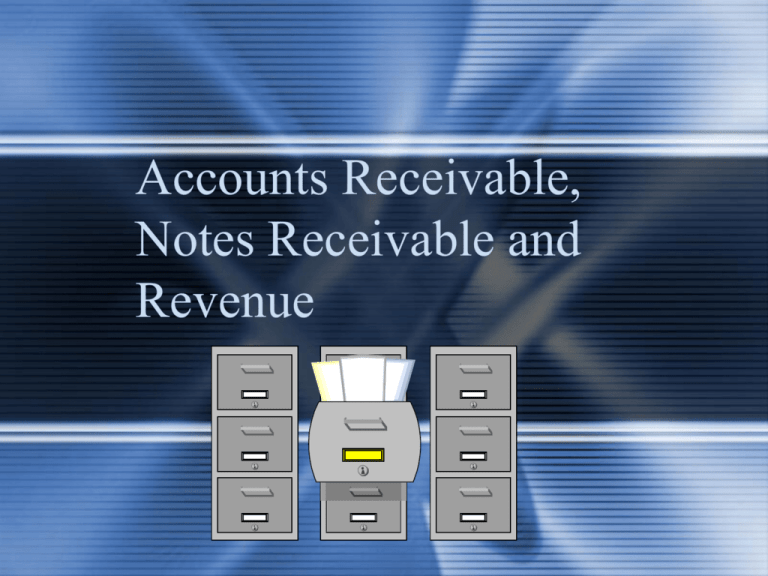
Accounts Receivable,
Notes Receivable and
Revenue
11-2
Internal Control Over the
Revenue Cycle
McGraw-Hill/Irwin
Controlling customers’ orders
Credit approval
Issuing merchandise
Shipping
Billing
Adjustments to sales and receivables
© 2004 The McGraw-Hill Companies, Inc., All Rights Reserved.
11-3
Revenue Cycle--Documents
Customer purchase order
Sales order
Bill of lading
Invoice
Control listing
Credit memo
McGraw-Hill/Irwin
© 2004 The McGraw-Hill Companies, Inc., All Rights Reserved.
11-4
Revenue Cycle Controls
McGraw-Hill/Irwin
Segregation of duties--sales and collections
Matching of sales invoices and shipping
documents
Clerical accuracy checks on invoices
Credit approval for sales transactions
Mailing of monthly statements
Reconciliation of bank accounts
Use of control listing of cash receipts
Use of budgets and analysis of variances
Control over shipping and billing documents
Use of authorized credit memoranda
Use of chart of accounts and review of account
codings
© 2004 The McGraw-Hill Companies, Inc., All Rights Reserved.
11-5
Potential Misstatements--Revenue
Recording unearned revenue
Early (late) recognition of revenue
Recording revenues when significant
uncertainties exist
Recording revenues when significant
services still must be performed
Overestimation of the amount of revenue
earned
McGraw-Hill/Irwin
© 2004 The McGraw-Hill Companies, Inc., All Rights Reserved.
11-6
Objectives for the Audit of Receivables
and Revenue
Consider inherent risks of receivables and revenue, including
fraud risks.
Consider control risk for receivables and revenue.
Substantiate the existence of receivables and the occurrence of
revenue transactions
Establish the completeness of receivables and revenue
transactions
Determine that the client has rights to the recorded receivables
Establish the clerical accuracy of records and supporting
schedules
Determine that the valuation of receivables and revenue is at
appropriate net realizable value
Determine that the presentation and disclosure of receivables
and revenue are adequate
McGraw-Hill/Irwin
© 2004 The McGraw-Hill Companies, Inc., All Rights Reserved.
11-7
Substantive Tests of Receivables and
Revenue
McGraw-Hill/Irwin
Obtain aged listing of receivables and reconcile to ledgers
Obtain analyses of notes and related interest
Inspect notes on hand and confirm those held by others
Confirm receivables with debtors
Review the cutoff of revenue transactions
Perform analytical procedures
Review significant year-end sales contracts
Verify interest earned
Evaluate the propriety of accounting for revenue transactions
Evaluate accounting estimates related to revenues
Determine the adequacy of the allowance for uncollectible accounts
Ascertain the existence of pledged receivables
Investigate receivables from related parties
Evaluate the business purpose of significant and unusual sales
transactions
Evaluate financial presentation and disclosure
© 2004 The McGraw-Hill Companies, Inc., All Rights Reserved.
11-8
Confirmation of Receivables
Receivables should be confirmed, unless:
Accounts receivable are immaterial,
The use of confirmations would be
ineffective, or
The auditors’ combined assessment of
inherent and control risk is low, and audit
risk can be reduced to acceptably low level
with substantive tests
McGraw-Hill/Irwin
© 2004 The McGraw-Hill Companies, Inc., All Rights Reserved.
11-9
Flowchart of the Confirmation Process
Develop Audit Objectives
Choose Appropriate
Confirmation Form
Determine the timing
and extent
Identify the information
to be confirmed
A
Prepare and Mail
the Requests
Send 2nd requests for
positive confirmations
Perform alternative
procedures for
non-respondents
Resolve exceptions
Select the accounts
for confirmation
A
McGraw-Hill/Irwin
Document the
procedures and
results
© 2004 The McGraw-Hill Companies, Inc., All Rights Reserved.
11-10
Criteria for Recognition of Revenue
Persuasive evidence of an arrangement exists
Delivery has occurred or services have been
rendered
The seller’s price to the buyer is fixed or
determinable
Collectibility is reasonably assured
Source: SEC Staff Accounting Bulletin No. 101.
McGraw-Hill/Irwin
© 2004 The McGraw-Hill Companies, Inc., All Rights Reserved.
11-11
Potential Revenue Recognition Problems
Sales with unusual right to return
Side agreements
Franchise fees
Bill and hold transactions
Sales using notes with unusual interest rates
Percentage-of-completion method of revenue
recognition
Multiple element agreements
McGraw-Hill/Irwin
© 2004 The McGraw-Hill Companies, Inc., All Rights Reserved.





